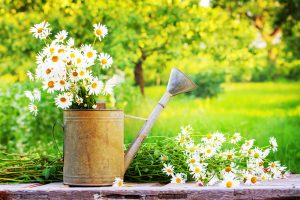The landscape of your yard does not have to be burdensome and high maintenance to express beauty. With each season comes simple tasks that create a lawn and hardscape that can bring years of plush green, vibrant color and enjoyment for your family. Following these tips as the summer closes ensures a fresh, renewed landscape next spring.
 End of Summer Maintenance Tips
End of Summer Maintenance Tips
While none of the hints below require much time, a local landscaping company can help boost your know-how or service your yard when you have other things on your to-do list. Either way, lawn care and end-of-season landscape maintenance proves valuable.
Know Your Zone
Plant hardiness maps provide information on the growing season and weather elements which impact watering, soil and lighting requirements in your region. This helpful guide lets you know which plants survive well the winter in your area of New Jersey. In fact, this map lays out four zones in this state based on average winter temperatures over the last 30 years.
Address Distress
The end of summer proves ideal to check for areas of your lawn needing more water, or fewer bugs and diseases. This season is a perfect time to test the soil for the nutrients, PH levels and other natural balances leading to healthy grass. Also, addressing brown spots, thinning grass and other signs of pests in the late summer prepares your yard for the spring.
Boost Your Hardscape
To create an even more maintenance-free landscape, up the hardscape. Yes, beds of shrubs, perennials and natives prove less demanding than lawns. Be sure to choose plants that tolerate the New Jersey climate year round.
Basic Considerations
Considerations of sunlight and shade, space, moisture, drainage, and deer prevalence affect your planting options. For instance, look for species that fit your space when fully grown, perform over the long-term, and resist insects, disease. and deer. This is where zone knowledge comes in handy. Native plants prove to be an easy-to-grow, low maintenance choice. After all, they are well acclimated to your region’s climate. A few New Jersey natives to consider include:
— Virgin’s Bower for multiseasonal interest.
— Foamflower as a ground cover between traditional hostas and ferns.
— Maidenhair Fern offers low maintenance green foliage.
— Eastern Bluestar for pest-free star-shaped summer beauty and yellow fall color.
— Merrybells as an easy-to-grow option.
More Options
Along with natives, flowering shrubbery, edibles. and perennials such as easy-to-grow soapwort or astilbe in pink, red, white or lavender offer color and individuality. Deer-resistant plants such as catmint, Jack-in-the-Pulpit or Japanese painted fern make for even more maintenance-free options.
Consider the Lawn
Switch to a late-summer fertilizer to ensure a beautiful spring lawn. Consider New Jersey conditions, the state of your grass and other local factors to determine whether to use an overall turf building fertilizer or one to address specific issues, such as pest control. This time of year plants, including grass, soak in all the nutrients they can, making it the ideal time to fertilize.
Aeration Matters
Aeration of your lawn as summer ends boasts rewards as well. A landscaping contractor offers this service, which helps bring fertilizer, water. and oxygen to your grass’ roots. A month before the first frost, remember to seed over your current lawn for lush growth in the spring.
Get a Good Trim
Lawns grow faster as the weather cools. So, sharpen the lawn mower blades that have dulled after a summer of use and go for a clean cut. However, avoid cutting grass too low to protect tender roots, and never cut more than a third off at one time. Plus, trimming bushes and shrubs will keep things neat. Be sure to know the best pruning and shaping techniques for each plant, shrub or tree. This knowledge produces the best growth come spring.
Gather the Trimmings
Be sure to collect dead grass and rake any leaves during this time. Both of these tasks allow sunlight and nutrients to get to lawn roots. While layers of grass trimmings or leaves protect your yard through the cold winter, they suffocate or breed disease during this time of year. So, rake them up, jump in them a few times for nostalgia’s sake and then clean them up.
Combat the Weeds
As mentioned, end-of-summer plants, including weeds, are taking in all they can to prepare for winter rest and spring rebirth. Applying herbicide reaps benefits in the spring with less dandelion growth. This time proves ideal as best application practices recommend temperatures be above 60 degrees consistently for optimum fertilizer performance.
As is said, an ounce of prevention is worth a pound of cure. This rings true with landscape design and maintenance. Caring properly for your lawn at the close of summer, addressing problem areas, choosing the right plants and preparing for spring boasts a lush yard and beautiful landscape. A landscape contractor offers useful advice and services.
Thank you for reading our blog! How can we help you? Contact us today.
